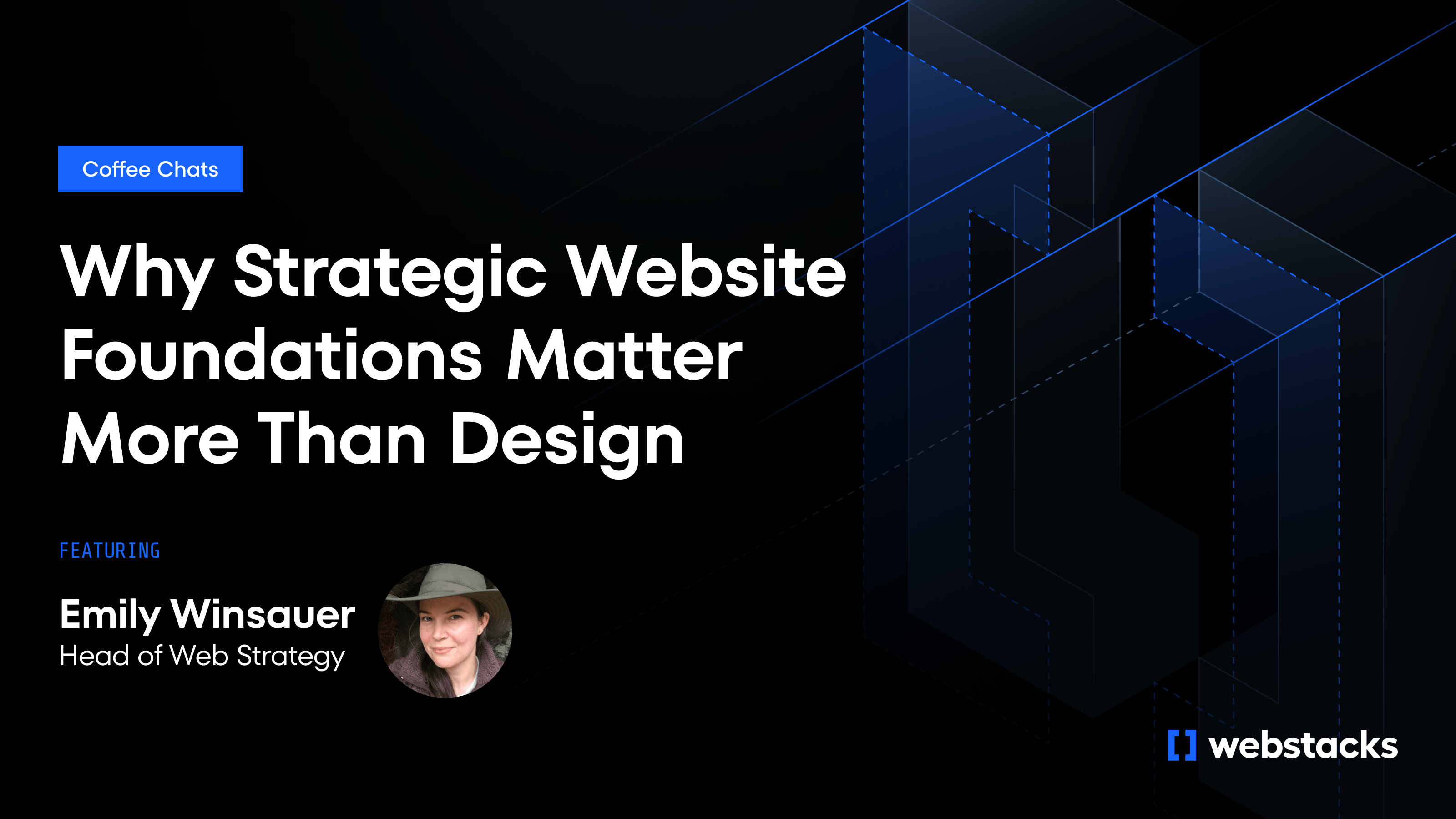Search engines are evolving fast, and enterprises need to evolve with them. Today, search users are often served direct answers through featured snippets, “People Also Ask” boxes, voice assistants, and AI-generated summaries before clicking a link.
Answer Engine Optimization (AEO) is the practice of structuring and presenting content so that it can be easily understood and surfaced by modern answer engines. It’s what determines whether your brand shows up when a potential customer asks Google, ChatGPT, or Perplexity a question relevant to your offerings.
For enterprise teams, this is a strategic opportunity. The right AEO approach can help your product pages, help centers, and thought leadership content show up in the most visible spots on the SERP without paying for ads.
In this guide, we’ll explain how enterprises can implement AEO at scale. You’ll also see how Webstacks’ modular approach to enterprise web design, CMS implementation, and content governance enables high-performing AEO strategies.

What Is Answer Engine Optimization?
AEO is the process of structuring and formatting your content to provide direct, accurate answers to users’ questions. These answers can be easily extracted and displayed by search engines, voice assistants, and AI-powered tools.
Unlike traditional SEO, which focuses on improving rankings and clicks, AEO focuses on visibility without the click. It's about meeting users where they are: in featured snippets, People Also Ask boxes, Google’s Search Generative Experience (SGE), or even in voice responses from Siri and Alexa.
To qualify for these placements, your content needs to clearly answer common questions using structured data formats (like schema markup) and semantically rich language that search engines can understand.
In short, AEO is what puts your enterprise content in the spotlight when users are looking for quick, trusted answers, often before they even visit your website.
Enterprise Use Cases Where AEO Drives Business Impact
For enterprise organizations, AEO is a driver of visibility, efficiency, and customer trust.
1. Product and Feature Pages
Enterprise buyers often search for specific product capabilities or integrations (e.g., “Does [Product] support Salesforce integration?”). AEO ensures that these answers are pulled directly into search results, making your product stand out before a user even lands on your site.
With AEO, your product pages become powerful tools for boosting visibility in search results, showcasing key features and benefits upfront.
2. Support and Knowledge Bases
FAQs and help articles are ideal candidates for featured snippets and voice search results. AEO turns your knowledge base into a customer-facing asset that reduces ticket volume while increasing brand credibility.
3. Thought Leadership and Blog Content
Executive insights, industry explainers, and trend analyses can be optimized to appear in AI overviews and "People Also Ask" queries. Enterprises investing in content marketing gain broader reach and higher engagement by formatting content to align with how answer engines parse and surface information.
4. Localized and Multi-region Experiences
For global enterprises, structured data becomes essential in supporting AEO across languages and markets. Implementing localization strategies with schema markup ensures region-specific content is prioritized in local search results and answer engines.
Core Elements of a Successful Enterprise AEO Strategy
Here are the foundational elements your strategy needs to succeed:
Structured Data and Schema Markup
Answer engines rely on structured data to understand and present your content. Applying schema types like FAQPage, HowTo, Product, or Organization helps search engines recognize key information.
At Webstacks, we ensure every reusable website component is schema-ready, so structured data is built into your site architecture from day one.
Clear Content Formatting
Your content must be scannable and concise to be surfaced in featured snippets or voice searches. Think paragraph-style answers to specific questions, bulleted lists for processes, and tables for comparisons. Modular content blocks make it easier to standardize this format across hundreds of pages.
Internal Linking and Semantic Relationships
Answer engines evaluate topical authority based on how well your content connects semantically. Implementing SEO optimizations, like a smart internal linking strategy, improves crawlability and increases the odds of being chosen as a featured answer.

Content Governance Across Teams
Maintaining content accuracy is a challenge for enterprises. Outdated information can cost you visibility or worse, customer trust. Establishing editorial workflows, documentation standards, and AEO-specific content reviews improves consistency across departments and markets.
Performance-Ready Web Architecture
Fast load times, mobile optimization, smart URL structures, and accessibility are non-negotiable for SERP visibility.
Investing in high-quality enterprise website design ensures that your site looks professional and also performs well. Jamstack architectures (e.g., headless CMS + static site generation) offer the performance benefits that answer engines reward while also reducing maintenance overhead.
How to Implement AEO Across an Enterprise Web Architecture
Scaling AEO across a complex enterprise website requires content tweaks and a deliberate integration of AEO principles into your site’s architecture, CMS, and workflows.
Modular, Schema-Ready Components
AEO starts at the design system level, incorporating principles of atomic web design. At Webstacks, we build reusable components such as FAQ blocks, how-to sections, and definition callouts that are pre-configured with schema markup.
This approach lets marketers create AEO-optimized pages without engineering involvement.
CMS Configuration for Structured Data
Enterprise-grade headless CMS platforms such as Contentful, Sanity, and DatoCMS allow teams to manage structured content in a scalable way. With the right content model in place, fields like “Question,” “Answer,” or “Step-by-step Instructions” can be mapped directly to structured data, making your content instantly usable by answer engines.
Support for Localization and Multi-site Governance
Global organizations need AEO to work across languages and regions. That means setting up localization frameworks within your CMS, ensuring schema is adapted to each locale, and maintaining governance to keep distributed content consistent.
Training and Documentation
AEO is an ongoing capability. Webstacks equips enterprise teams with the documentation, Loom tutorials, and async training needed to maintain structured content at scale, so AEO doesn’t fall through the cracks post-launch.
How Webstacks Helps Enterprises Win with AEO
Enterprise AEO requires more than content. It demands a foundation of scalable systems, structured design, and cross-team alignment. A web design and development agency such as Webstacks can help you here.
Strategic Discovery and AEO Opportunity Mapping
Every engagement begins with a deep dive into your content ecosystem. Developing a comprehensive website development roadmap ensures that all aspects of your site are aligned with AEO best practices from the outset. Through stakeholder interviews, SEO audits, and competitive analysis, we identify where AEO can create the most impact, whether that's product pages, support hubs, or multilingual content libraries.
Schema-Enabled Design Systems
Webstacks builds modular components that are AEO-ready from the start. Each component comes with built-in schema markup and functional variations, so content editors can publish answers that answer engines recognize without extra dev effort.
CMS Implementations That Empower Marketers
We implement headless CMS platforms like Contentful, Sanity, and DatoCMS with AEO in mind. Our setups allow marketing teams to input and manage structured content directly, complete with fields mapped to schema, localization support, and governance rules.
Proven Results Across Enterprise Clients
We’ve applied this approach across a range of enterprise teams. For ServiceTitan, we replatformed their marketing site and helped scale web operations, making it easier to manage content at speed. For Snowflake, we rebuilt their Snowflake University microsite with a scalable design system that dramatically improved SEO performance.
Improve Your Enterprise SEO with AEO
As search behavior evolves, so must enterprise SEO strategies.
AEO is a core component of digital visibility. With AI-generated overviews, voice assistants, and SERP features reshaping how users access information, enterprises must deliver structured answers that rise above the noise.
But AEO also represents a shift in how content is created, managed, and scaled. For enterprise organizations, that means building the right foundations: modular components, schema-enabled CMS architecture, and cross-functional governance.
At Webstacks, we help enterprise teams operationalize AEO—from design system strategy to implementation and training—so your content can perform in today’s search engines and tomorrow’s.
Looking to optimize your enterprise website for the future of search? Contact us to get started.




